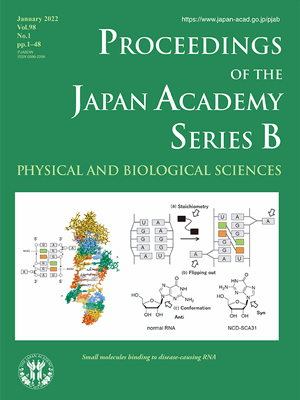About the Cover
Vol. 98 No. 1 (2022)
RNA has emerged as a drug discovery target. In addition to proteins, which have been targeted in conventional drug discovery research, RNA has been recognized as an important drug discovery target for the future. There are high expectations for the development of small-molecule compounds that regulate RNA functions, because drug discovery resources such as small-molecule compound libraries held by drug discovery companies, as well as development technologies and know-how, can be utilized. However, there are few examples of the development of small molecule compounds that regulate RNA functions, and there are also few examples of the accurate elucidation of the complex structure of RNA and small molecules. This has led to a situation in which drug discovery researchers do not know what kind of compound binds to the target RNA. The elucidation of specific compounds that bind to RNA and regulate its function, and the precise complex structure of the compound and RNA, is expected to be the key to accelerating RNA-targeted drug discovery research. In their research to create small molecules that bind to mismatched base pairs of nucleic acids, Nakatani et al. (see the article in this issue, pp. 30-48) succeeded in developing small molecules that bind to repeated sequences of nucleic acids that cause neurodegenerative diseases. Spinocerebellar ataxia type 31 is caused by UGGAA repeats, which are transcripts of long TGGAA repeats inserted into human chromosome 16. UGGAA repeat RNA is thought to trap RNA-binding proteins in the nucleus.
Nakatani et al. showed that naphthyridine carbamate dimer (NCD) binds to the hairpin structure of UGGAA repeats and alleviates the degeneration of compound eyes in a Drosophila SCA31 model. The structure of the NCD-bound complex was analyzed using nuclear magnetic resonance NMR spectroscopy, and it was found that two molecules of NCDs were mutually hydrogen-bonded to four guanine bases, and two adenine bases were expelled from the duplex. In addition, the four guanine bases were found to adopt a syn-glycosidic structure. The precise structure and characteristics of these complexes will provide important insights into the creation of small molecules that bind to RNA.
Naoki Sugimoto
Director and Professor of Frontier Institute for Biomolecular Engineering Research (FIBER), Konan University




